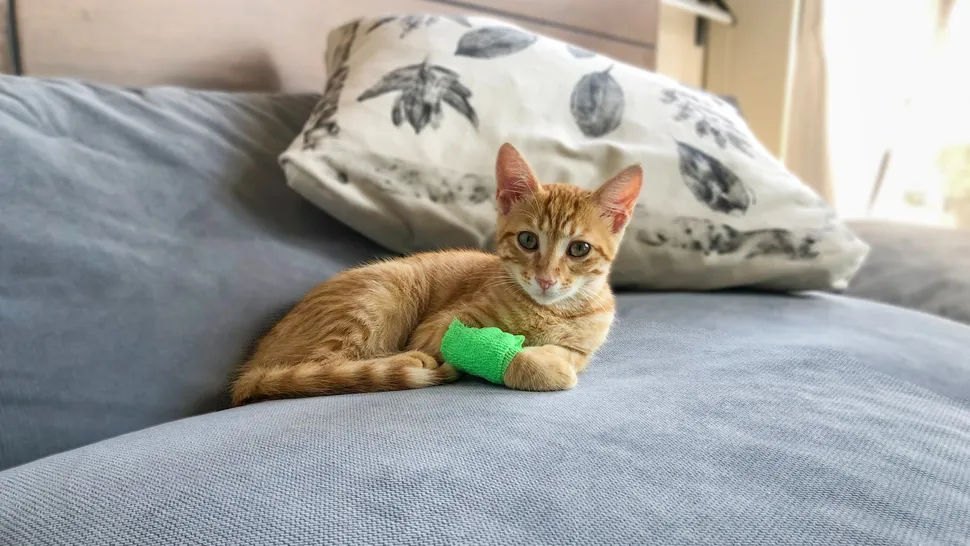Why is my cat limping? A typical question frequently asked by cat owners on various cat forums. Well, many things can make your cat limp.
The cause can range from simple to complicated. It is advisable to seek an immediate medical appointment with your veterinarian in case you notice a limping symptom.
The veterinarian will diagnose the limping cat and identify the cause of the problem. He will, therefore, recommend certain treatments and rehabilitation measures to consider during the healing process.
In this article, Kelvine Bruce DVM is going to walk you through some of the common causes of cat limping and treatment measures to consider.

Why Is My Cat Limping
Lameness is a medical term used to describe cat limping behavior. Here are the possible reasons for lameness:
1. Infections
There are quite a good number of infections that can affect your feline friend both internally and externally leading to limping.
Some of the common things triggering an infection in cats are Lyme disease, calicivirus, Abscess, and bacterial infection from the wounds.
Open wounds on the feline paw could be the possible cause of the limping and if it is not treated on time then bacterial infection is likely to occur.
2. Soft Tissues Injuries
Strained muscle or ligament is also a possible cause of cat limps. The strained or sprained muscle usually lasts for a couple of days and a cat returns to its normal walking style.
However, the straining will result in some swellings and this will require home treatment. You can use a warm compress or heat pack.
Torn ligaments are considered to be a serious cause of lameness and this may require a further diagnosis from a professional vet.
3. Fractures
Cats are skittish and playful. They love jumping from one point to another regardless of the height especially when hunting a mouse.
Jumping from a high point could result in broken bones or even dislocation which make her or him start limping.
The fractures may cause severe pain and even restrain the movement of the cat. Therefore, splint the injured limp and visit the vet for treatment.
4. Arthritis
Arthritis causes pain and stiffness in the joints of the cat. The health condition is quite common in old cats.
The health problem is quite worse in the morning and colder days. Felines with this problem usually experience a hard time when walking or standing.
Limping due to arthritis usually gets worse as the cat grows older and there is no exact treatment. The vet will only administer painkillers to relieve the pain.
5. Paw Pad and Claw Injuries
Open wounds on the paw pad and claw injuries are some of the other possible causes of cat limping.
The open wounds on the paw pad could be due to sharp cuts from broken glasses or splinters. Nail injuries can also be quite painful to the cat causing the limping behavior.
It is recommended to examine the cat paw carefully between the toes and also the claws to determine the cause of lameness.
6. Snake or Insect Bite or Sting
Cats are curious creatures and they are highly susceptible to bites or stings. The forelimb of the cat is quite vulnerable to bites from snakes especially when hunting.
Insect bites and stings can also make your feline friend limp. The limping behavior occurs due to the swellings accompanied by pain.
If you notice weird symptoms like vomiting, diarrhea, drooling, and dilated pupils then it could be due to a venomous snake bite. Call your vet immediately.
7. Abnormal Heartworm Migration
Heartworms are parasites that enter the feline through mosquito bites. These parasitic roundworms rarely affect cats like other animals.
These parasites usually reside in the heart and during migration, they tend to move to various parts of the body like legs.
It is quite easy to tell a cat suffering from the condition since they usually limp most of the time. Therefore, always see the vet in case of cat limping for diagnosis.
8. Cat Overweight
Obese cats tend to experience lameness than normal-weight cats. The extra weight tends to add more pressure on the joints, muscles, and bones.
Overweight cats usually experience a reduced level of activity since any intense activity will make them limb most of the time.
9. Hip Dysplasia
Domestic cats that are well taken care of tend to live for a long period and they tend to experience hip dysplasia condition in their old age.
The condition occurs when the bone on top of the leg doesn’t fit in the hip joint perfectly. It will later result in pain and even inhibit cat movement.
Consult your vet for diagnosis and treatment recommendations. This will help to reduce the limping behavior.
Should I See the Vet If My Cat Is Limping?
If you are still asking the question: why is my cat limping? It may be time to take them to a VET. Cats are stronger than dogs and this is why they rarely cry or howl when in pain. They hate showing any sign of weakness to potential predators.
If you notice that your feline friend has lost appetite, spends most of the time alone, and even refuses you to come close to his legs.
This is a clear sign that there is a problem. Seek veterinarian help immediately. The vet will recommend certain treatments for minor or serious injuries and rehabilitation measures to follow until healing is done.
It is advisable to have the habit of taking your feline friend for a check on a quarterly or semi-annually basis. This will help to foster the healthy fitness of your pet.
Diagnosis of Cat Limping Symptom
The vet will take a detailed history record of your pet and also a general physical examination to identify the possible cause of lameness.
Sometimes, cat limping could be due to orthopedic disorders and a serious neurological examination will be taken.
In the case of fractures, radiography will be undertaken to determine the exact point on the leg before administering any form of treatment.
Treatment of Limping Cat
Treatment of cat lameness depends on the cause. In case of minor strains on muscles, you will be required to rest your pet for a couple of days.
When the cause of the limping is unknown, your vet will recommend rest and administer anti-inflammatory medicines to relieve the pain.
In case the cat fails to respond to the medication then he or she will be hospitalized for further tests and examination. Surgery is usually the last resort.


